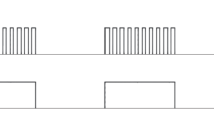Abstract
Diagnostic instruments are nowadays an integral medicine part. Instruments try to make work of doctors easier. The measured data are often poorly understood by the layperson, so it is important that the physician sufficiently explains the information obtained from the biosignal. However, sometimes this information is not necessarily important. When measuring electromyographic signals during rehabilitation or training of athletes, rapid feedback is essential. This paper deals exclusively with the creation prototype of an electromyograph measurement chain with a quick and simple presentation of the electromyographic signal for the layperson. Signal pre-processing is discussed and many presentation variant of electromyographic signal. Such as acoustic output, lighting of LEDs by EMG, visualization of the EMG signal intensity on a cascade of LEDs and playback of the selected sound when the set intensity of the electromyographic signal is exceeded. The device has the ability to adjust the level of difficulty to monitore progress.
Access this chapter
Tax calculation will be finalised at checkout
Purchases are for personal use only
Similar content being viewed by others
References
Cases, C.M.P., Baldovino, R.G., Manguerra, M.V., Dupo, V.B., Dajay, R.C.R., Bugtai, N.T.: An EMG-based gesture recognition for active-assistive rehabilitation. In: 2020 IEEE 12th International Conference on Humanoid, Nanotechnology, Information Technology, Communication and Control, Environment, and Management (HNICEM), pp. 1–6. IEEE (2020)
Chan, B., Saad, I., Bolong, N., Siew, K.E.: A review of surface EMG in clinical rehabilitation care systems design. In: 2021 IEEE 19th Student Conference on Research and Development (SCOReD), pp. 371–376. IEEE (2021)
Darak, B.S., Hambarde, S.: A review of techniques for extraction of cardiac artifacts in surface EMG signals and results for simulation of ECG-EMG mixture signal. In: 2015 International Conference on Pervasive Computing (ICPC), pp. 1–5. IEEE (2015)
Gotuzzo, J., Vu, S., Dee, S., George, K.: Electromyography based orthotic arm and finger rehabilitation system. In: 2018 IEEE International Conference on Healthcare Informatics (ICHI), pp. 338–339. IEEE (2018)
Kieliba, P., Tropea, P., Pirondini, E., Coscia, M., Micera, S., Artoni, F.: How are muscle synergies affected by electromyography pre-processing? IEEE Trans. Neural Syst. Rehabil. Eng. 26(4), 882–893 (2018)
Kim, Y.H., Kim, S.J., Shim, H.M., Lee, S.M., Kim, K.S.: A method for gait rehabilitation training using EMG fatigue analysis. In: 2013 International Conference on ICT Convergence (ICTC), pp. 52–55. IEEE (2013)
Malboubi, M., Razzazi, F., Sh, M.A., Davari, A.: Power line noise elimination from EMG signals using adaptive laguerre filter with fuzzy step size. In: 2010 17th Iranian Conference of Biomedical Engineering (ICBME), pp. 1–4. IEEE (2010)
Matsubara, M., Terasawa, H., Kadone, H., Suzuki, K., Makino, S.: Sonification of muscular activity in human movements using the temporal patterns in EMG. In: Proceedings of the 2012 Asia Pacific Signal and Information Processing Association Annual Summit and Conference, pp. 1–5. IEEE (2012)
Merletti, R., Farina, D.: Surface Electromyography: Physiology, Engineering, and Applications. Wiley, Hoboken (2016)
Merletti, R., Parker, P.J.: Electromyography: Physiology, Engineering, and Non-invasive Applications, vol. 11. Wiley, Hoboken (2004)
Poonsiri, J., Charoensuk, W.: Surface EMG based controller design for knee rehabilitation devices. In: The 4th 2011 Biomedical Engineering International Conference, pp. 131–134. IEEE (2012)
Preston, D.C., Shapiro, B.E.: Electromyography and neuromuscular disorders e-book: clinical-electrophysiologic correlations (Expert Consult-Online). Elsevier Health Sciences (2012)
Rastogi, R., et al.: Which one is best: Electromyography biofeedback, efficacy analysis on audio, visual and audio-visual modes for chronic tth on different characteristics. Int. J. Comput. Intell. IoT 1(1), 25–31 (2018)
Sheng, G., Wang, L., Ma, D., Fan, F., Niu, H.: The design of a rehabilitation training system with EMG feedback. In: 2012 International Conference on Biomedical Engineering and Biotechnology, pp. 917–920. IEEE (2012)
Suhaimi, R., et al.: Analysis of EMG-based muscles activity for stroke rehabilitation. In: 2014 2nd International Conference on Electronic Design (ICED), pp. 167–170. IEEE (2014)
Tsubouchi, Y., Suzuki, K.: Biotones: a wearable device for EMG auditory biofeedback. In: 2010 Annual International Conference of the IEEE Engineering in Medicine and Biology, pp. 6543–6546. IEEE (2010)
Weiss, J.M., Weiss, L.D., Silver, J.K.: Easy Emg-E-Book: A Guide to Performing Nerve Conduction Studies and Electromyography. Elsevier Health Sciences, Philadelphia (2022)
Winter, D.A.: Biomechanics and Motor Control of Human Movement. Wiley, Hoboken (2009)
Author information
Authors and Affiliations
Corresponding author
Editor information
Editors and Affiliations
Rights and permissions
Copyright information
© 2022 The Author(s), under exclusive license to Springer Nature Switzerland AG
About this paper
Cite this paper
Prochazka, M., Kasik, V. (2022). Electromyograph as a Tool for Patient Feedback in the Field of Rehabilitation and Targeted Muscle Training. In: Pietka, E., Badura, P., Kawa, J., Wieclawek, W. (eds) Information Technology in Biomedicine. ITIB 2022. Advances in Intelligent Systems and Computing, vol 1429. Springer, Cham. https://doi.org/10.1007/978-3-031-09135-3_30
Download citation
DOI: https://doi.org/10.1007/978-3-031-09135-3_30
Published:
Publisher Name: Springer, Cham
Print ISBN: 978-3-031-09134-6
Online ISBN: 978-3-031-09135-3
eBook Packages: Intelligent Technologies and RoboticsIntelligent Technologies and Robotics (R0)




